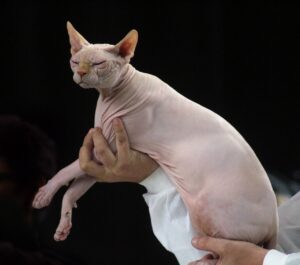A cat lover may want to adopt several different cats, but they might find several obstacles blocking their way. There’s the issue of keeping them all cleaned and maintained. On top of all that, one also has to consider the allergens that come with keeping a pet.
Many people have the misconception that it is the cat’s hair that triggers allergies, but that’s usually not true. The actual triggers are the proteins that are secreted by the cat’s skin. The main culprits are the Fel d1 protein that’s in the skin and the Fel d4 protein that’s in the saliva of most cats. These two proteins might be dangerous to certain people, but there is a way around this issue; namely, going for hypoallergenic cat breeds.
Of course, no cat breed is completely hypoallergenic, but there are some types that don’t shed so much hair or dander. Certain other breeds don’t have enough of the harmful proteins to create an effect. If your interest is already piqued, check out these cat breeds that won’t trigger anyone’s allergies much:
1. Sphynx
This hairless hypoallergenic breed might not look like your typical cat, but it’s certainly a unique kind. While the appearance is strange, people who own these cats usually report that they’re quite endearing and make good pets.
However, keep in mind that a Sphynx cat requires a certain level of special care. The requirements include giving regular baths, using the right products, and making sure the temperature is just right.
Since these cats don’t have hair to form a protective barrier, their skin is usually sweaty and oily. This results in the need for weekly baths if you want a healthy, clean pet. A medicated pet shampoo, warm water, and a gentle hand are necessary if you want to keep a Sphynx cat. While this is a hassle, the bath time will probably form a stronger bond between the pet and its human.
While the Sphynx cat’s saliva does have the allergy-triggering proteins, these can’t get trapped in its fur. There’s no fur to harbor either dander or saliva, so the pet owners are usually safe with this breed.
2. Cornish Rex
The Cornish Rex breed has a gorgeous tabby coat, though it’s not very thick. Most cat breeds have three layers of fur. There’s a top hair that guards the layers below; the middle or awm hair, and the downy bottom hair. The Cornish Rex, though, has just the bottom coat. This means less hair to shed and less space to harbor the proteins.
Another advantage of getting this breed is that they have a very soft coat. You can have fun stroking this cat while also staying mostly safe from its allergens.
However, Cornish Rex cats still require a certain level of maintenance. They need frequent baths, for one, in order to maintain their clean, suede-like fur coat and do away with the frequent oil buildup.
3. Devon Rex
The Devon Rex breed has similar qualities to the Cornish Rex, especially where the cat is concerned. These cats only have the down coat. The amount of hair is also very little as compared to other breeds. With these qualities, you know that there’s very little chance of getting an allergy-trigger protein anywhere near a human family member.
It’s also said that the Devon Rex breed is a friendly and affectionate one. The lack of hair might make it less cuddly than others, but it still makes for a warm cuddle when you need it the most.
4. Oriental
Oriental Shorthair cats have short coats with very fine hair. They look sleek and elegant; plus, their coat doesn’t shed too much. This quality is good news for those who are allergic to felines.
If you do decide to get this particular breed, make sure you give your cat a thorough brushing on a regular schedule. This practice will help to do away with any hairs that might be coming loose. When you remove these airs on a regular basis, there will be fewer strands around your home.
5. Russian Blue
While Russian blue cats may look pretty, their coat still sheds the normal amount. What makes them a hypoallergenic breed is the fact that they produce less of the Fel d 1 protein form their skin than other feline breeds. Since this is the protein that actually causes the allergy, Russian Blues are a great option for those looking for hypoallergenic breeds.
6. Bengal
There’s no proof that the skin of Bengal cats produces a lower amount of Fel d1 protein than other cats. However, they have short coats that look like pelts but shed much less frequently on average.
Another advantage here is that their coats stay neat, tidy, and clean without much help from their owners. This means that you don’t need to maintain this breed too much. The cat itself won’t have to groom its own coat very often, resulting in less salvia inside the hairs.
7. Siberian
Siberian cats might not look like a hypoallergenic breed, but that lovely long coat isn’t really harmful to most allergy sufferers. They may shed hair and skin like a regular cat, but their dander doesn’t contain too much Fel d1 protein.
The hair floating around your space might still make some household members uncomfortable, so you may want to think twice about this option. If there are no injections and you really want a cat with a luxurious coat, try a Siberian as soon as possible.
8. Balinese
This cat is another one of the breeds that don’t produce a hefty amount of the dangerous Fel d1 protein. They’re hence not so likely to trigger any allergic reactions. If you want to lower the chances even further, make sure to brush their coat regularly and vacuum the spaces they visit most frequently. You may also want to invest in HEPA air filters to be on the safe side.
9. Javanese
We’ve already mentioned the three coats of fur that most cats have. The Javanese breed only has the topcoat, unlike the Cornish Rex or Devon Rex. While the Javanese breed may not have a downy covering, they still have less hair to shed.
10. Burmese
Burmese cats are blessed with silky yet short hair. This makes it one of the best hypoallergenic breeds around. Not only will the short hairs shed less, but the skin also produces fewer allergens.
Most specimens of this breed have a beautiful sandy color. Other colors may also occur, but the golden eyes are what really set this cat apart.
In addition to the hypoallergenic quality, the personality of the Burmese makes it a high recommendation. They’re fond of people and very loving; some even say that they act like dogs when it comes to loyalty!
Conclusion
If you or a family member is allergic to cats, getting a specimen from any of the breeds above can be a logical compromise. However, make sure to spend some time with a cat of your chosen breed first. You can do this by fostering such a cat or offering to take care of one for some time. If the cat doesn’t trigger any allergic reactions, you can start the process of getting your own furry family member.


